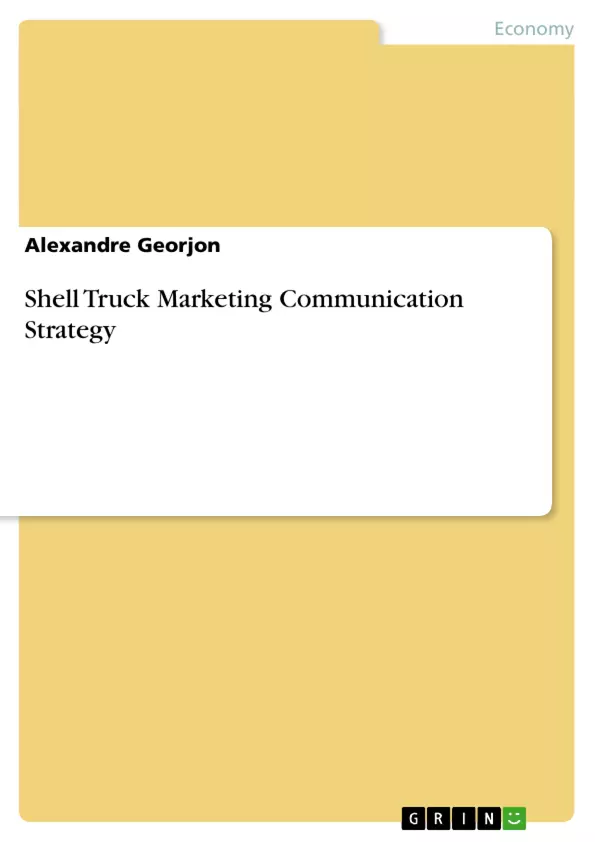Shell is a company providing different products and services for the CRT
market. This highly competitive market, dominated by Q8, reduces Shell’s sources
of profitability and therefore Shell launch a major campaign to develop a stronger
position.
The campaign will target existing and potential fleet managers and drivers.
The concept is to drive the fleet manager to the EuroCargo exhibition in Cologne,
major place of meeting for the European companies in the transport sector with a
multistage Direct Marketing process. To back up this campaign, specialised
magazines and sponsorship of events and traffic radios are planned before and after
the trade-fair. This event will also correspond to the launch of the new brand
(TranShell) specially build up for the CRT market, in order to add some values
(flexibility, integration, expertise, etc.) necessary to this B2B sector.
Finally, the effectiveness of the campaign will be maximised by using
on-going and post campaign measurement methods. This campaign is the Shell’s
first step to offer a fully integrated provision of solutions by developing innovative
products and services.
Inhaltsverzeichnis (Table of Contents)
- EXECUTIVE SUMMARY
- CONTENT
- BACKGROUND
- MARKETING OBJECTIVE AND STRATEGY
- Marketing objective
- Segmentation
- Communication objective
- POSITIONING
- Positioning for Shell on CRT market
- Repositioning
- Integrated marketing communication campaign
- CORPORATE COMMUNICATION
- Public relations
- PR messages
- Other PR activities
- PROMOTIONS
- TranShell Loyalty strategy
- Event-linked promotions
- Sponsorship
- CREATIVE STRATEGIES
- Positioning
- Primary Competition
- Promise
- Reasons Why
- Tone Statement and Execution
- MEDIA STRATEGY
- Budget
- Seasonality
- Media Strategy
- Primary medium: Press Advertisements
- Magazines
- Detailed Budget
- Secondary medium: Traffic Radio Advertisements
- Radios
- Budget
- International Relevance of Media
- DIRECT MARKETING
- Schedule (Cf. Chart Section 3.3)
- Direct Marketing Budget
- EVALUATION OF CAMPAIGN
- CONCLUSION - RECOMMENDATIONS
- Recommendations
- APPENDIX
- Appendix 1: Transportation Market Structure
- Appendix 2: Picture of Present Situation of Shell CRT
- Appendix 3: Picture of the new brand: TranShell
- Appendix 4: Image repositioning
- Appendix 5: Brand Onion
- Appendix 6: Magazine details budget
- Appendix 7: Magazine details budget
- Appendix 8: Direct Marketing detailed budget
- Appendix 9: Advertisement for Fleet Managers
- Appendix 10: Advertisement for Drivers
- REFERENCES
- Developing a unified brand for the CRT market.
- Positioning Shell effectively in the CRT market against competitors.
- Creating a multi-stage Direct Marketing campaign to engage with fleet managers and drivers.
- Leveraging public relations, events, and media strategies to promote the new brand and drive awareness.
- Implementing a comprehensive evaluation plan to measure the effectiveness of the campaign.
- Background: This chapter provides an overview of the CRT market, including its size, diversity, and key players. It also presents a SWOT analysis of Shell's current position in the CRT market, highlighting its strengths, weaknesses, opportunities, and threats.
- Marketing Objective and Strategy: This chapter outlines the specific marketing objective of the campaign, which is to increase Shell's sales and market share in the CRT market. It then details the proposed marketing strategy, which focuses on market penetration strategies. The chapter also discusses market segmentation and communication objectives.
- Positioning: This chapter addresses the critical issue of Shell's brand positioning within the CRT market. It outlines the proposed positioning strategy, focusing on differentiating Shell from its competitors by highlighting its unique value proposition. The chapter also discusses the development of an integrated marketing communication campaign.
- Corporate Communication: This chapter explores the various elements of corporate communication that will be employed to support the campaign. It includes sections on public relations, PR messages, and other PR activities.
- Promotions: This chapter examines the promotional aspects of the campaign. It includes sections on TranShell loyalty strategies, event-linked promotions, and sponsorship initiatives.
- Creative Strategies: This chapter focuses on the creative elements of the campaign, including positioning, primary competition, promises made to customers, reasons why those promises will be fulfilled, and the overall tone and execution of the campaign.
- Media Strategy: This chapter outlines the media strategy for the campaign, including the budget allocated, seasonality considerations, and the specific media channels that will be used. The chapter details the use of press advertisements and traffic radio advertisements, providing specific budgets for each medium. The international relevance of the chosen media channels is also discussed.
- Direct Marketing: This chapter explores the direct marketing component of the campaign, detailing the schedule and budget for the direct marketing activities. The chapter also provides links to additional information about the campaign, including the chart section (Section 3.3) of the document.
- Evaluation of Campaign: This chapter focuses on the methods that will be used to evaluate the effectiveness of the campaign. It highlights the importance of ongoing measurement and post-campaign analysis to ensure that the campaign achieves its objectives.
Zielsetzung und Themenschwerpunkte (Objectives and Key Themes)
The primary objective of this document is to outline a comprehensive marketing communication campaign for Shell in the Commercial Road Transport (CRT) market, specifically targeting fleet managers and drivers in Western, Central, and Eastern Europe. The campaign aims to increase Shell's sales and market share in this sector, while simultaneously strengthening its brand position.
Zusammenfassung der Kapitel (Chapter Summaries)
Schlüsselwörter (Keywords)
The main keywords and focus topics of this marketing communication campaign for Shell in the CRT market are: Shell, CRT market, fleet managers, drivers, marketing communication, market penetration, branding, positioning, integrated marketing campaign, public relations, direct marketing, media strategy, evaluation, and recommendations. The document also highlights key themes like market segmentation, customer loyalty, competitive analysis, and the development of innovative products and services to address the specific needs of the CRT market.
- Citar trabajo
- Alexandre Georjon (Autor), 2003, Shell Truck Marketing Communication Strategy, Múnich, GRIN Verlag, https://www.grin.com/document/23348



